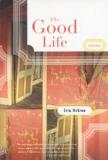Woe Are They
The good life in The Good Life is brittle, fragile, ironic, impermanent. And it is often Catholic.
In these 11 short stories, Erin McGraw, author of three books and professor of creative writing at Ohio State University, watches, hears and records contemporary America in 15-page snatches. She drops into Los Angeles, the Bay Area, Chicago, Indianapolis, Cincinnati and western Maryland. She visits apartment, houses, bars, churches, seminaries. She probes singles, marrieds, families, churches, support groups and young professional women. The America she finds is sad and unstable, often flirting with psychology or New-Age religion for some elusive peace.
McGraw’s opening story, “The Beautiful Tennessee Waltz,” tells of three Bay Area couples: Stephanie and Jeff (in a fragile marriage), Charlotte and Martin (her “ex” and a difficult person), and Alice and Dik (who once apologized to a pine tree “for the travesty of Christmas” and changed his name from “Richard” to “Dick” to “Dik” “as a way of honoring his desire for simplicity”). Stephanie and Martin are sort of in love, and Jeff once had an affair with Charlotte. With grand irony, Stephanie and Jeff throw a second anniversary party for Alice and Dik—“the Panic Anniversary,” Martin says, when the newness has passed and “you realize you’ve signed on for the duration.”
Cutting remarks dot the story. Stephanie on Martin: he “had faith in marriage—for its difficulty.... For the pure challenge.” Stephanie on ice: “Secretly she’s miserable. She only thinks she’s happy.” Stephanie to Martin: “You’re like a dog that’s found something disgusting to roll in. You’re ecstatic about how awful you can make yourself feel.” Stephanie on her marriage: “We eat take-out and watch TV. We have extended conversations about [their cat] Toulouse. Jeff does a terrific imitation of Cary Grant. It’s a good life.” As the story ends, people dance to “The Tennessee Waltz,” and Dik cries out, “This is joy, whether you like it or not.” I felt a touch of terror: is this our America?
At the book’s other end, the story “One for My Baby” offers the possible beginning of romance between Aless and Patrick, encased in irony and uncertainty. Scattering his first wife’s ashes on a California mountain, he utters a yoga invocation, looses doves from a cage (they’re really pigeons) and tries to sing. Emitting only “a little croak,” he’s coached by Aless, then “opens his mouth again and does a little better.” These words end the book and are, I suspect, its maximal hope. In between these stories lie other brittle relationships and marriages, often fueled by alcohol or drugs or infidelity or fad-mysticism or old social activism. Such is The Good Life, Erin McGraw’s acute view of young Americans.
Catholic stories—or stories with Catholic touches—make up over half of this collection. In “A Whole New Man,” religion is just a few passing phrases: “Sweet Jesus,” “the answer to my prayers,” “Jesus Christ, that’s enough.” “Daily Affirmations” includes a phone call from a monsignor, a pious mother’s daily Mass, talk about “a blessing” and “God’s will,” and family Mass on Christmas. “Ax of the Apostles” and “The Penance Practicurn” are more overt, being set in seminaries. The first, a heavy comedy about a pudgy priest-professor, his seminarians and an inflated mannequin named Alice, touches on compassion and self-giving. The second features conservative seminarians, a Halloween party and a botched moral exam. In “Appearance of Scandal,” Father Marino, a good pastor, drinks too much, gets too close to women, enters rehab and years later still feels trapped in his priesthood. (McGraw’s Catholic lore fails her in this story: Father Marino wears green vestments for a wedding.) And her Catholic imagination? Unlike the imaginations of, say, Ron Hansen or the late Andre Dubus, who probe sacrament and ritual and motivation, McGraw mainly records catch phrases or the surfaces of parish or seminary life. I’m not sure she understands priests, and her laypeople are often shallow, with responses more psychological than religious.
In my own university, I regularly teach postmodernism for insight into contemporary culture. Though McGraw’s techniques are not postmodern—using, for example, a self-referential structure or an unreliable narrator—her stories are filled with postmodern people who are fragile, brittle, unstable, ironic. She knows young marrieds, Catholics and otherwise, and makes us wonder whether cool, distancing, clever irony is the style of our time. The answer, I fear, may be yes.
This article also appeared in print, under the headline “Woe Are They,” in the September 27, 2004, issue.








